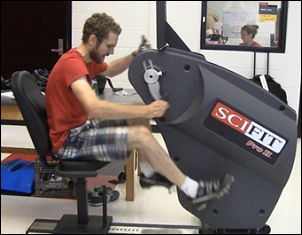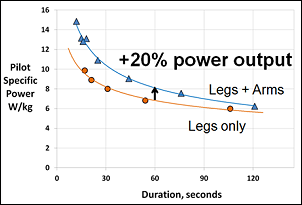
Test pilot Kyle Gluesenkamp on the SCIFIT Pro2 Total
Body Recumbent Bike machine.
The heart of Gamera II is the human pilot. As the aircraft’s engine and accounting for 2/3 of the total vehicle weight, the human component needs as much or more engineering focus than other vehicle parts.
Gamera I made use of hand cranks to boost power output in the 15-20 second flight range. The Gamera II goal was longer flight durations, on the order of 60 seconds, so the team conducted more testing on the addition of hand cranks to validate this design choice.
 |
|
Initial pilot power test results showing that adding hand cranks and engaging the upper body results in increased power output for the short flight durations of interest. |
Using a commercial exercise machine that includes both leg and arm motion, comprehensive experiments were performed on test pilots. The results confirmed a power benefit, up to 20% for a 60-second effort, by using hand cranks in addition to the typical leg cranks.
A recruitment effort resulted in three test pilots for Gamera II. They are all in the same weight range of 135-145 lbs and have excellent power to weight ratios (W/kg). And all are scientists or engineers at the University of Maryland!
